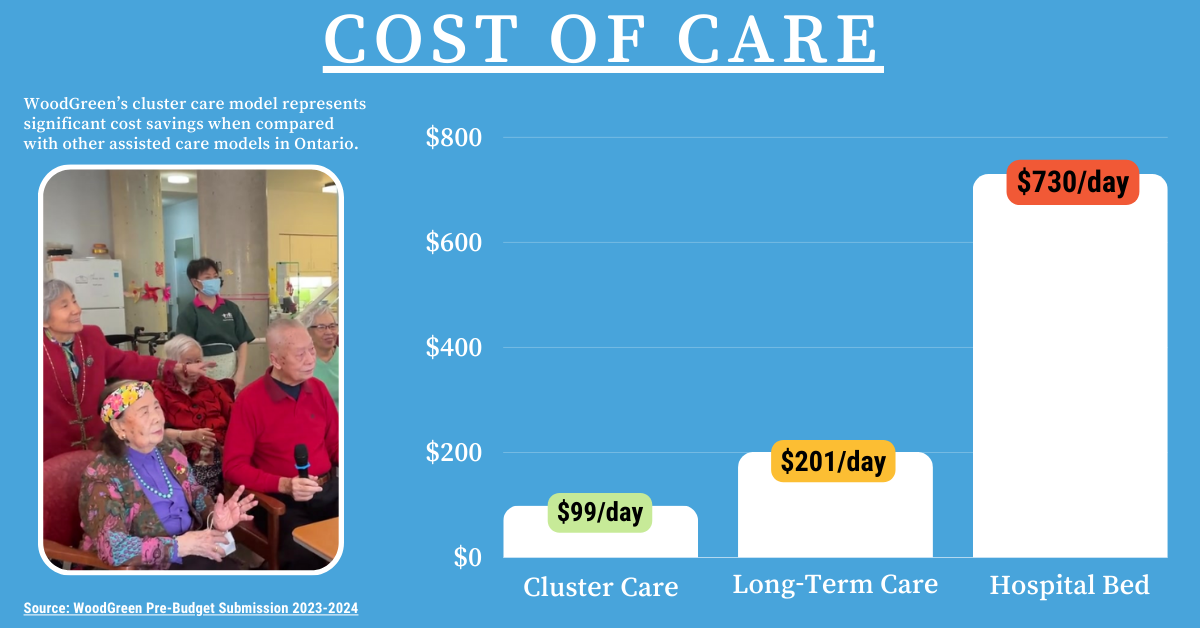A unique approach to assisted care is adding to the quality of life of seniors while reducing pressure on hospitals and long-term care, all for a fraction of the cost of traditional care models.
WoodGreen’s Cluster Care model provides seniors with private rooms within a shared living space, round-the-clock assisted care from personal support workers and socialization that keeps clients feeling young.
“I feel like I’m 29,” says Luu Chan, “but my body is actually 92.” He lives in one of WoodGreen’s six cluster care sites where all residents are over the age of 59 and need some level of full-time support.
Shrinking both care costs and wait lists
Cluster care gives frail seniors the opportunity to live independently. Even more, it also alleviates pressure on an increasingly strapped public health system, where hospitals remain overcrowded with patients who don’t really need hospital care, but who can’t safely be sent home either.
Known as alternate level of care (ALC) patients, recent data found they occupy nearly 6,000 hospital beds. The cost of care in a hospital bed is $730 per person, per day.
Few are transferred quickly, as waitlists for long-term care have almost doubled over the last decade, with nearly 40,000 people waiting for a bed.

On average, seniors wait six months for a space in long-term care, with some waiting as long as 2.5 years. WoodGreen’s cluster care prevents alternate level of care clients from occupying hospital beds. This model has successfully diverted 75 per cent of the cluster care clients away from long-term care.
The Ontario Long Term Care Association says the province “needs more than 30,000 new long-term care spaces to serve the number of people currently on the long-term care wait list.” It says Ontario needs another 48,000 spaces within the next five years to keep up with increased demand.
‘We are like one big family’
Chan was one of those patients. He always led an active life as a Tai Chi master instructor at York University. But when a stroke landed him in hospital last year, doctors didn’t advise him to return to living alone.
Rather than keeping him in a hospital bed while he awaited space in a long-term care facility, the hospital reached out to WoodGreen to ask about a room at the cluster care.

Chan’s case is a prime example of why WoodGreen developed the program in the early 2000s.
“As the number of seniors in Toronto increases, this model is vital to providing an additional option for care while alleviating pressure from hospitals,” says Jennifer Sampson, Director of Senior and Aging at WoodGreen Community Services.
The model is designed to be co-ed, with between nine and 11 seniors living in a complex of private rooms with common living, dining and kitchen areas where residents can gather to socialize and enjoy mealtimes.
Personal Support Workers are on hand 24 hours a day, for both client safety and to assist with residents’ individual needs, including advanced frailty and those with mental health and neurological disorders such as Alzheimer’s disease and other dementias.
Finding assisted-living support at WoodGreen’s cluster care
“The residents and the workers here, we are like one big family,” says Chan. He lives in one of three Chinese-speaking clusters where all residents and support workers converse in Chinese.
Cost savings of cluster care
Cluster care is a model that not only benefits seniors, it also provides an enriched quality of life at a far lower cost than many other care options.
If Chan had stayed in hospital, the cost to care for him would have been on average $730 per bed per day. If he had been transferred to a long-term care facility, that cost would average $201 per day. A place at WoodGreen’s cluster care site costs $99 per day.

The true value in the cluster care model, however, is one residents say cannot be measured in dollars and cents.
“Living here is so much better than anywhere else,” says 93-year-old Joe Agnes. She was one of the first residents in the very first WoodGreen cluster care site 20 years ago and has stayed ever since.
Both she and Chan say they enjoy the food, which is culturally sensitive to the residents, who receive three cooked meals and two snacks per day. They often eat as a family, spending time together when they feel like it, or opting for privacy when they don’t.
Active bodies, active minds
It is this effort to prevent isolation among seniors that truly sets the cluster care model apart. Research shows that an estimated 30 per cent of seniors are at risk of social isolation, something which the International Federation on Aging identifies as the number one emerging issue facing seniors in Canada.
Every Tuesday, WoodGreen picks up the residents and brings them to its Seniors Active Living Centre, where they take part in activities, workshops, cultural events and outings. This connects residents with others in the community while helping them stay healthy and active.
Back at home, support workers are on site 24 hours a day, seven days a week. They help with personal care, meal preparation, medication reminders, grocery shopping and more.
‘I have immediate help’
“I feel safe, comfortable and secure here,” says Agnes. “If you live alone, you still need to go out and shop and cook and what if something happens to you? Here, I have immediate help. There is always someone here to help me and that makes me feel safe.”
Meanwhile, Chan credits cluster care for helping him stay happy and healthy by giving him support, socialization, routine and a reason to get up every day. And get up he does; every morning at 4 a.m. he’s up doing stretches before joining the others for breakfast. Later, he leads everyone in a tai chi practice.
“I wouldn’t get this at home. I need to stay physically and mentally active, and I can do all of that here,” he says, with a smile.
Discover the benefits of our Cluster Care Program by following this LINK.





